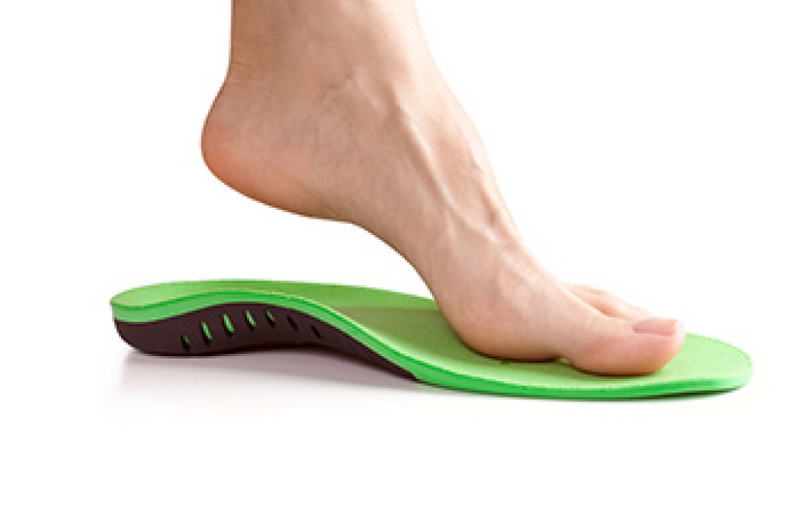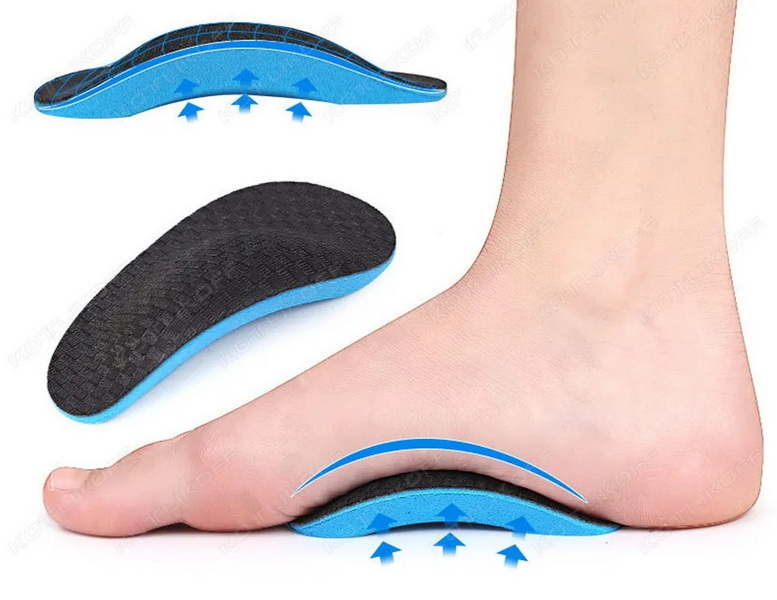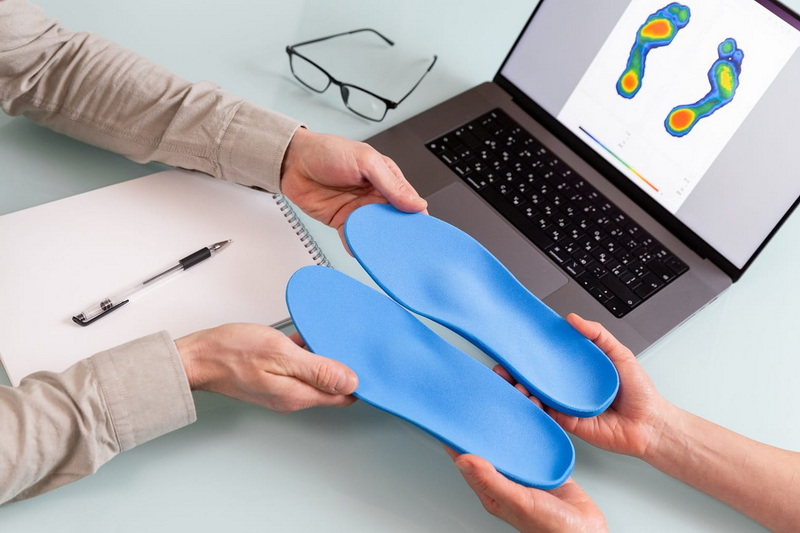Views: 222 Author: Edvo Publish Time: 2025-10-27 Origin: Site











Content Menu
● How To Place Arch Support Inserts?
● Understanding the Purpose of Arch Supports
● Understanding Foot Arch Types
● Selecting the Right Arch Support Inserts
● Step-by-Step: How To Place Arch Support Inserts
>> Step 1: Remove the Existing Insole
>> Step 2: Align the Heel Section
>> Step 3: Align the Arch Area
>> Step 4: Check for Proper Fit
>> Step 5: Wear-Test for Final Adjustment
>> Step 6: Allow a Break-In Period
● Common Mistakes During Placement
● Why Proper Placement Matters
● Manufacturing Quality Ensures Accuracy
● Tips for Long-Term Use and Maintenance
● Expanding Market Demand for Arch Support Inserts
● The Role of Arch Supports in Athletic Performance
● Custom OEM Options for Brand Partners
● Smart Arch Support Technology
● Testing the Effectiveness of Placement
>> 1. Where exactly should the arch support be placed in the shoe?
>> 2. Can I use arch support inserts without removing the original insole?
>> 3. How do I know if the arch support fits correctly?
>> 4. How often should I replace my arch support inserts?
>> 5. Are arch supports suitable for flat feet?
Arch support inserts are vital for maintaining proper foot alignment, improving posture, and reducing fatigue during daily activities. Many people wear shoes that don't provide adequate support, which can lead to discomfort, joint pain, and long-term health issues. Properly placing arch support inserts can transform ordinary shoes into comfortable, ergonomic footwear designed to protect and support your feet throughout the day.
If you're a brand owner, wholesaler, or shoe manufacturer, teaching your customers how to correctly position arch supports increases satisfaction and reduces product returns. As a leading Chinese insole OEM, we provide custom-designed arch supports that help international partners deliver professional-grade comfort and support for all types of shoes.

Arch supports are designed to balance body weight evenly across the foot, prevent overpronation (inward rolling), and maintain the natural curvature of the arch. Improper support can alter the way a person walks or stands, putting unnecessary pressure on the ankles, knees, hips, and spine. When placed correctly, inserts act as shock absorbers and stabilizers, reducing discomfort during walking, exercising, or standing for extended hours.
Users often overlook that even small differences in placement can influence comfort, performance, and even the longevity of their shoes. That's why understanding how to position them correctly is crucial not only for daily use but also for athletic or medical applications.
Each person's foot arch is unique, and recognizing the type of arch helps in selecting and positioning the correct kind of support:
- Low Arch (Flat Feet): The foot makes almost complete contact with the ground, often leading to overpronation. A firm arch insert helps support the middle of the foot and maintain structural balance.
- Normal Arch: The most common type. These feet benefit from medium-height arch supports that enhance natural motion without creating pressure.
- High Arch: These feet display a pronounced curve that causes uneven pressure distribution. Deep-contoured and cushioned supports help fill the space between the foot and the shoe.
Correct placement is based on understanding this building block of biomechanics. Proper alignment ensures the insert supports your foot's natural form rather than forcing it into an unnatural position.
Not every shoe or activity requires the same insert type. As an OEM producer, offering various configurations helps end-users tailor their comfort experience:
- Full-Length Inserts: Extend from heel to toe, ideal for athletic or work shoes.
- Three-Quarter Length Inserts: Cover the arch and heel, suited for dress or tight-fitting shoes.
- Gel-Based Supports: Excellent for shock absorption and long-standing periods.
- Memory Foam Inserts: Adapt to the shape of the foot for personalized comfort.
- Thermoplastic or Carbon Fiber Orthotics: Provide rigid control for structural corrections.
Encourage your clients to consider activity type and shoe design before choosing inserts. For sports performance, additional heel cushioning and reinforced arch zones are ideal. For everyday walking shoes, flexible and breathable materials provide the right blend of comfort and durability.
Start by gently removing the shoe's original insole. This frees up space and ensures that the arch insert fits correctly without raising the foot too high.
Place the new insert so that the heel area perfectly matches the shoe's heel pocket. The back of the insole should sit snugly and flat without folding.
Next, find the natural curve of your arch by feeling the bottom of your foot. The highest point of the insert should rest directly beneath this area—not too far forward or too close to the heel. When aligned correctly, you should feel uniform support under your arch when standing.
Ensure that the toes have enough space to rest flat in the toe box. The insert should not crowd the front part of the shoe or cause tightness. If needed, trim along the guide lines using scissors for a custom fit.
Put on your shoes and walk around for several minutes. You should notice balanced pressure across the foot without pinching or discomfort. Reposition slightly if one side feels elevated or uneven.
New users might experience mild discomfort for the first few days as the feet adapt. It's best to wear the inserts for a few hours per day, gradually increasing usage over a week.
Even small errors can reduce performance or cause irritation. Avoid these common mistakes:
- Placing Inserts on Top of Original Insoles: This can lift the foot too high, creating instability.
- Ignoring Arch Alignment: Misaligned inserts cause imbalance and may worsen foot pain.
- Using Wrong Shoe Sizes: Oversized or undersized inserts distort placement.
- Neglecting Shoe Type Compatibility: An insert designed for running shoes may not fit dress shoes.
- Skipping the Break-In Phase: Immediate full-day wear can lead to soreness.
By educating consumers, manufacturers and distributors build trust and improve brand reputation.
Positioning arch supports correctly ensures the following benefits:
- Better Weight Distribution: Even pressure reduces soreness in heels and the balls of the feet.
- Improved Balance: Proper alignment stabilizes posture during walking, running, or standing.
- Reduced Joint Stress: Aligning the foot prevents strain in the knees, hips, and lower back.
- Enhanced Shoe Comfort: Inserts maintain the internal shape of footwear over time.
- Extended Shoe Lifespan: Even pressure prevents uneven sole wear and enhances durability.
Customers often realize better overall comfort and performance simply from correcting the placement rather than changing the product.

High-quality inserts begin with precision manufacturing. As a Chinese OEM factory, we use advanced techniques to achieve consistency and comfort:
- 3D Foot Scanning: Captures exact foot contours for customized mold design.
- High-Density EVA Foam: Provides durability while maintaining flexibility.
- Antimicrobial Layers: Keep the feet hygienic by reducing odor and bacteria.
- Breathable Fabric Liners: Improve ventilation and moisture control.
- CNC Cutting Precision: Guarantees clean edges and symmetrical shape.
Every production batch undergoes inspection for thickness, density, and resilience to ensure long-term performance in all footwear types.
Proper care extends the lifespan and comfort of inserts. Offer these maintenance tips to your customers:
- Clean gently with a damp cloth and allow to air dry.
- Avoid machine washing or exposing to direct sunlight.
- Replace every 6–12 months, or when cushioning wears out.
- Remove inserts overnight to let shoes ventilate.
- Use odor-control powders or sprays to maintain freshness.
Providing simple care instructions on packaging improves customer satisfaction and ensures repeat purchases.
Growing health awareness and urban lifestyles have fueled demand for ergonomic insoles across North America, Europe, and Asia-Pacific. Factors driving global growth include:
- Rising incidence of plantar fasciitis and overpronation.
- Increased participation in recreational sports and gym activities.
- Growing focus on comfort in both casual and business footwear.
- E-commerce platforms facilitating direct-to-consumer customization.
By offering OEM and ODM solutions, Chinese manufacturers can capture this rising demand through personalized branding, private labeling, and flexible production capacity.
Athletes rely on arch supports not only for comfort but also for improved stability and performance. Correctly placed inserts can enhance foot alignment during impact, minimizing energy loss and fatigue. For runners, they absorb shock during midfoot strikes, while for basketball players, they provide side-to-side stability.
When combined with breathable padding and resilient materials, these devices can significantly improve agility and endurance. Encourage customers to replace athletic inserts regularly—typically every 400 to 600 miles of use—to maintain optimal support.
Offering customization sets your OEM services apart and strengthens client loyalty. Common customization options include:
- Branded outsole or logo embossing
- Dual-density foam structure for improved cushioning layers
- Medical-grade materials for orthopedic footwear
- Targeted support zones for gender, age, or activity-specific models
By supporting flexible order quantities and sample-based prototyping, global partners can confidently introduce branded arch supports into their footwear lines.
Recent innovations have introduced smart insoles equipped with sensors that measure posture and pressure distribution. Some advanced designs feature:
- Integrated microchips for gait analysis
- Real-time pressure mapping through mobile apps
- Adjustable arch firmness via air or gel chambers
As wearable technology evolves, embedding these systems into OEM products will create new value propositions for both medical and fitness-conscious markets.
Encourage users to test their insert placement through simple checks:
- Stand on one foot—there should be no wobbling or inward collapse.
- Walk briskly—the heel and toe should roll smoothly without tilting.
- Press gently between the arch and ground—if the pressure feels balanced, placement is correct.
Even with proper placement, some users may experience discomfort. Common causes include:
- Excessive Pressure: Indicates that the insert arch height is too high for the user's foot type. Try a lower support.
- Slipping or Movement: The insert may be too small or the shoe interior too smooth. Use adhesive pads if necessary.
- Uneven Feel Between Feet: One foot might have a slightly different arch. Offer custom-molded inserts or adjustable designs.
Customer education and after-sales support reduce dissatisfaction and improve product usability.
Placing arch support inserts correctly is a simple yet powerful step toward improving comfort and foot health. By ensuring proper alignment, customers can reduce pain, maintain posture, and enhance performance in both daily and athletic activities. As a professional Chinese insole manufacturer, we supply innovative, OEM-customized arch supports crafted with premium materials, ergonomic precision, and attention to global comfort standards.
Empower your customers with well-designed instructions, visual guidance, and professional support. Combined with superior product quality, this ensures that every user experiences maximum comfort—one step at a time.

The peak of the arch support should rest directly under the foot's natural arch, approximately one-third from the heel. Proper alignment keeps the foot stable and supports natural motion.
It's better to remove the original insole first unless the insert is designed for additional placement. Overlapping layers can create tightness and throw off shoe fit.
When standing, the insert should support the arch without pressing too hard. The toes should feel relaxed, and there should be no heel lift or internal slipping.
Typically every 6–12 months. For frequent runners or heavy users, replacement may be needed earlier to maintain full support and cushioning.
Yes. For flat feet, choose firm medial arch support with deep heel cups to prevent inward rolling and maintain proper alignment.